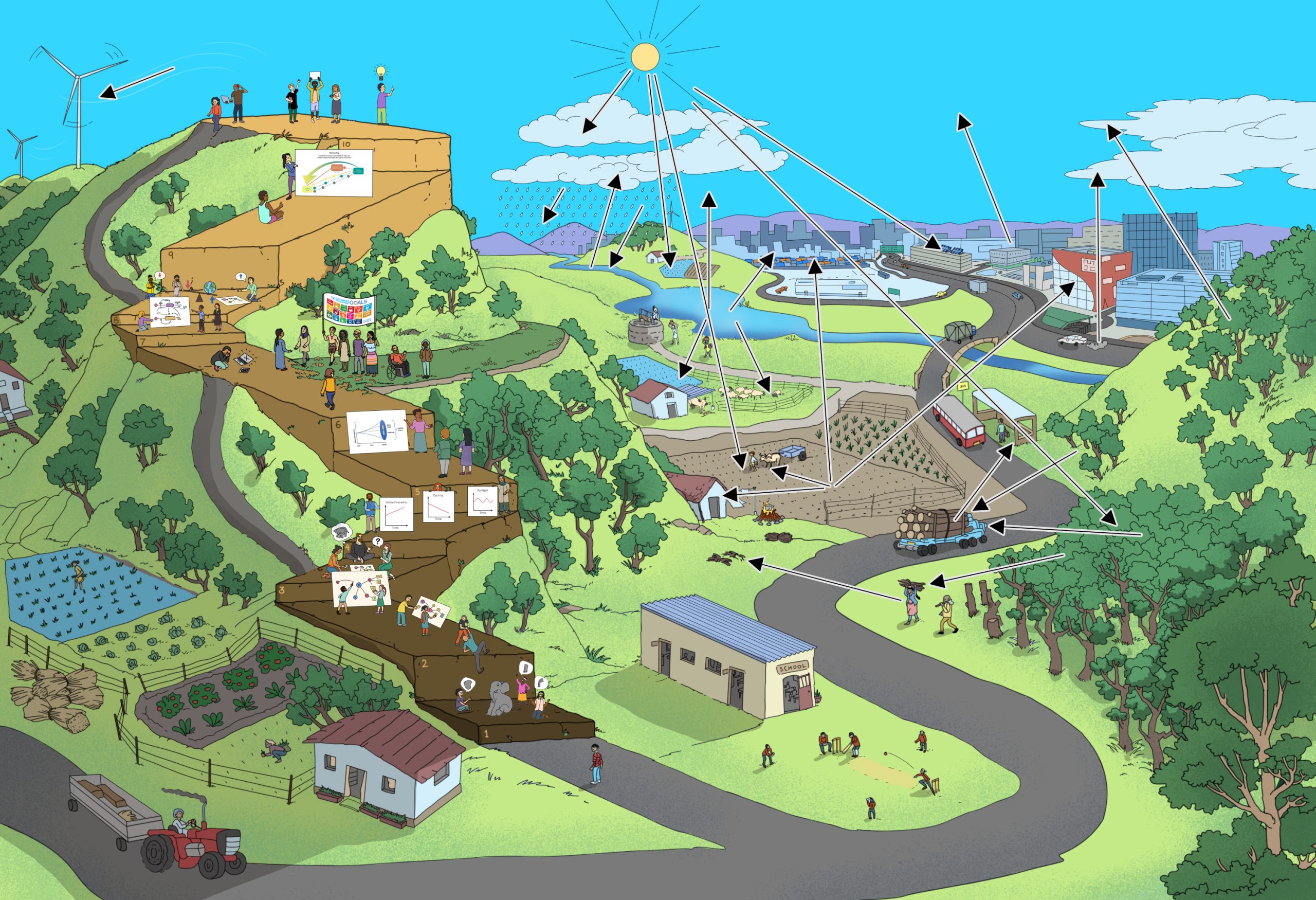Systems thinking is the ability to describe and/ or visualise a part of a complex reality, express that part of reality as a model, understand the model as a system, use the model to explain the behaviour of the system, anticipate the behaviour of the system, and evaluate its impacts on sustainable development, identify potential points of, and types of interventions, generate options to act, assess their impacts in the frame of sustainable development, and decide whether further actions are necessary or not.
1. What does this mean?
In the first five Steps, learners have developed and applied their understanding of systems thinking. They created a systems model of their chosen topic and made projections about the behaviour of the system in the future. In this Step, learners are introduced to the concepts of sustainable development (SD). They assess whether and how the system contributes to sustainable development, and whether the current and future behaviour would continue to do so.
If the system contributes to SD, then what are the ways of maintaining and perpetuating it? In case it does not, or rather if it increases unsustainable behaviours, such as increased pollution, then, what are the ways of changing the system? These dimensions are discussed in the next steps (Step 6 onward).
For this, it is essential to:
- Understand criteria of SD.
- Identify current and future impacts of the system.
- Assess the anticipated impacts of the system in the frame of sustainable development. The impacts may be internal as well as external to the system. Moreover, there may be dilemmas in classifying impacts for or against SD.
2. What is the aim?
To enable learners to
- become aware of the concept of SD.
- become aware of various frameworks, criteria, and their strengths and limitations, to assess development or SD.
- evaluate the current and future behaviour of selected parameters of a system for their impact on SD.
4. Activities, tasks and suggested learning methods
In this Step, first, the learners become familiar with various concepts of Sustainable Development, such as Gross Domestic Product (GDP), Human Development Index (HDI), Ecological Footprint, Handprint, and the UN 2030 Agenda for Sustainable Development (17 SDGs). They should be exposed to the strengths and limitations of these. The 2030 Agenda is recommended as the preferred framework for SD to be used in this manual.
1. As a preparatory step, learners may watch the videos such as:
-
- The Story of Stuff
- Videos on 2030 Agenda, such as:
Transitioning from the MDGs to the SDGs
Sustainable Development Goals: Improve Life All Around The Globe
Nations United: Urgent Solutions for Urgent Times | Presented by Thandie Newton
2. Share the information sheet ‘What is Sustainable Development?’Ask the learners to recall Step 4, in which they described the functions and behaviours of the system and its subsystems as well as Step 5, in which they projected the expected behaviour of the system and its subsystems.
3. Now, using the framework of sustainability, learners try to link the system components with one or more the 17 Sustainable Development Goals and their Targets. Learners can refer to the website about the UN Sustainable Development Goals https://sdgs.un.org/goals. Share the worksheet ‘Measuring Development’ for the learners to analyse their system in the frame of SD.
4. Do learners encounter any dilemmas? For example: is it always possible to clearly identify whether the behaviour of any element in the system is becoming more or less sustainable? Is improved sustainability in one element happening at the cost of another? Learners should make a note of these dilemmas and come back to these in subsequent Steps.
Finally, the learners should develop:
- A list of criteria of SD applicable to the system, and selected variables.
- A written evaluation, including a list of identified contradictions and conflicts for SD that already exist, or may exist between different aspects of the system.
Learning methods suggested are:
- (SDG) Analysis Matrix
- Advocatus diaboli
- Explainity Video
- Indicators Eggs
- Group Jigsaw
- Panel discussion
- Podcast
- Role play /Analytic Teamby example Mock UN Conference
- Think Pair Share
Information sheet
What is Sustainable Development?
Worksheets
Measuring Development
5. Conclusion
- Reflect on what is learnt, either by summarizing the activity or asking learners to do so
- In this Step, learners should have become familiar with various concepts of Sustainable Development.
- Ask the group to think about and share further questions about the system they are exploring. The answers to these further leading questions may be discussed in the next steps.
Illustration of staircase model for further leading questions
6. Suggested Further Leading Questions
- Can I influence future developments?
- Can I influence future developments to be more in tune with SD?
- How can I do this?


